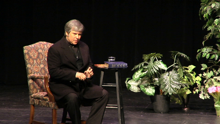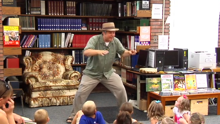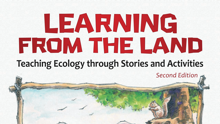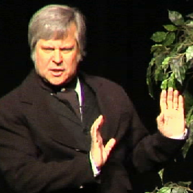Dear Katie, The Volcano Is a Girl
by Brian "Fox" Ellis,
Book Links May 1999
For most people today, the word myth means fiction, fallacy, or invented story, but for people throughout time in many cultures, myth speaks of a deeper truth. If science is a quest for understanding the truth, the origins of life, and the origins of the universe, then ancient myths were the first science. Jean Craighead George's recent children's picture book, Dear Katie, The Volcano Is a Girl, explores the point at which myth meets science.
This insightful story begins with a letter from a grandmother to her inquiring granddaughter. The young girl has tried to convince her grandmother, who thinks like a scientist, that the myth of the Hawaiian people that Pele, the Fire Goddess, gave birth to the Hawaiian Islands contains valid truths about the creation of these islands. The grandmother attempts to persuade Katie of the validity of the scientific theory that these islands were formed by molten magma seeping up through a crack in the earth's underwater surface to form a volcanic island. As each argues her points, we see that modern science actually supports the underlying truth of the myth. This dynamic picture-book conversation looks at the details of both sides of the argument and seamlessly weaves the two stories together until, finally, the grandmother has to agree with Katie. There are a growing number of excellent stories based on scientific principles and a vast collection of illustrated myths, but George's book is rare in respecting the truth of both perspectives.
Throughout the world, people tell stories of how things came to be. Mysterious mountains, unusually deep canyons, and precipitous cliffs are pregnant with stories of adventure, failure, and triumph. The Dine, or Navajo, people believe that the landscape stalks us with stories. These stories remind us of our place in the world; that cliff or this boulder reminds us of our relationships with each other and with the earth itself. The Aborigines of the Australian Outback use stories as a map to help them find their way in that bleak landscape. The stories are told at a walking pace as one crosses the land. As features of the landscape come into view, they remind one of the next chapter in the story; as the story unfolds, it reminds one which way to turn so one can get to the next watering hole, the next village, or wherever this chosen story leads one.
Such stories can be a powerful tool for teachers who want to bring geography to life. Many of these stories, though considered fiction or folklore, contain scientifically accurate interpretations of geological processes. For instance, the Shawnee people believe that the continent of North America, which they call Turtle Island, is shaped like a turtle and is swimming in the ocean. It takes very little imagination to see Florida and Baja California as legs and Mexico as a tail. The peninsulas of Alaska and Nova Scotia are front legs, and Greenland is the head. The truth is that North America is moving like a turtle, slowly, two to three inches per year. This is one reason for the earthquakes in California. An example from another type of myth can be found in the tall tales about Paul Bunyan. Paul and his ox are said to have plowed a trench that became the Mississippi River. That riverbed really is a plowed trench, though plowed by water, not by a lumberjack!
These stories can make flat maps multidimensional, adding drama and suspense to a better understanding of geography and geology. Myths also add multicultural dimensions to the teaching of geography.
Activities
After reading Dear Katie, The Volcano Is a Girl, students can make a list of the scientific concepts in the story and a parallel list of the mythic explanations. Discuss the similarities and differences in these lists.
Students can research and discuss how topographical maps are drawn, how elevation is measured, and how ocean depths are measured.
After reading several stories listed below, have students create their own science-based myths that blend geological processes with fantasy and imagination. First, using detailed topographical maps of your region or the world, ask students to choose their favorite place and draw a mural of this mountain, valley, or island. They could then research the geological processes that created their landform. Next, have them imagine how that place came to be, weaving in the facts from their research. These stories could be illustrated for a bulletin board or collected into a book of classroom mythology.
For more detailed lesson plans read the article Maps Tell Stories Fox wrote for Green Teacher Magazine
Related Picture Books
Baylor, Byrd. The Way to Make Perfect Mountains: Native American Legends of Sacred Mountains Illus. by Leonard F. Chana. 1997. 62p. Cinco Puntos, paper, $9.95 (0-938317-26-1). Gr. 1-5.
Beautifully erasing boundaries between science and mythology, Byrd Baylor uses her finely crafted poetry to illuminate the mountains of the desert areas of the Southwest. With an emphasis on magic and mystery, she retells Native American legends of sacred mountains that she has collected from her neighbors and from literary sources. The stippling technique used in the illustrations will help children view landscapes in new ways.
Kellogg, Steven. Paul Bunyon. 1984. 48p. Morrow, $16 (0-688-03849-2); paper, $5.95 (0-688-05800-0). Preschool-Gr.3.
Though the factual scientific information in this American tall tale is a bit sketchy, the pure exuberance and outrageous imagination displayed in the telling of the story, and the quirky illustrations filled with humorous and colorful details, surely compensate. The endpapers provide a good overview of the many landforms Paul Bunyan and his big blue ox Babe are credited with creating.
Rossman, Douglas A. Where Legends Live: A Pictorial Guide to Cherokee Mythic Places. Illus. by Nancy-Lou Patterson. 1988. 48p. Cherokee Publications, paper, $4.95 (0-935741-10-0). Gr. 2-5
Black-and-white photos, extensive site descriptions, and a keyed map constitute this ultimate field guide to the mythic places of the Cherokee homeland. The author gives a brief synopsis of each story mentioned. This guide underlines the need in all regions of our country for a richer relationship with the mythos of our home and a deeper appreciation for our environment.
Wargin, Kathy-Jo. The Legend of Sleeping Bear. Illus. by Gijsbert Van Frankenhuyzen. 1998. 42p. Sleeping Bear, $16.95 (1-886947-35-X). Preschool-Gr. 5.
In this well-told Ojibwa myth, a forest fire in Wisconsin forces a mother bear and her two cubs to swim across Lake Michigan. The cubs do not make it, leaving the mother to grieve upon the Michigan shore, forming Sleeping Bear Dunes. The cubs become North Manitou Island and South Manitou Island. The illustrator evidences scientific accuracy in his realistic renderings of the plant and animal life, and a useful map is included on the endpapers.










